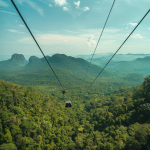The serene and majestic landscape of Phu Kradueng stands at the center of a heated discussion. Are we venturing into a new epoch of tourism evolution, or lifting the curtain on a misunderstood conservation strategy? At the center of it all is the persistent proposal of a cable car, a topic that’s been hanging in the air for over three decades.
Representing Loei’s Constituency 3, the indefatigable Saran Timsuwan of the Pheu Thai Party has emerged as a stalwart advocate of this project, passionately detailing its nuances and significance. He is succinct in his message: the 25.7-million-baht budget sanctioned by the government is earmarked for designing and conducting a meticulous Environmental Impact Assessment (EIA), integral to bringing the cable car project to life. Yet, Saran is keenly aware of the swirling misconceptions.
“The funds are religiously allocated. They’re not sidetracked for roads or, heaven forbid, electric trams snaking across the mountaintop,” he underscored, shaking off the skepticism voiced by the public in response to the Department of National Parks, Wildlife and Plant Conservation’s (DNP) tram proposal.
While critics quickly brand the cable car as a blatant nod towards mass tourism, Mr. Saran offers a narrative woven with layers deeper than mere escapism. At its core, he argues, the cable car is a crucial lifeline designed to bolster emergency readiness, streamline waste management, and provide seamless logistical support to the park’s guardians.
“Imagine battling a raging forest fire with the summit as your scene,” he compellingly paints the picture. “Heavy equipment like tractors can’t magically appear at the top. The machinery must be partially dismantled, hauled up manually. A cable car flips this arduous task on its head, offering swift, efficient transport for both manpower and equipment,” he explains.
For Mr. Saran, the prospective cable car offers relief—literally. No longer would porters bear cumbersome loads, nor would the park’s waste disposal woes mount unbounded. It’s about orchestrating an intelligent, responsible use of technology to foster conservation and ease burdens.
With an eye on environmental checks and balances, the proposed route has been a subject of prior studies to gauge its ecological compatibility. Mr. Saran speaks with an air of assurance that the DNP sees the wisdom in this thoughtfully premeditated route, poised to seamlessly merge accessibility with the delicate art of conservation.
“There’s precision and finesse involved. Every pylon’s placement, the depth reached during excavations, the robustness of foundations—each element hangs in balance with nature’s blueprint,” he articulated, underscoring the pivotal roles the design and the EIA processes encapsulate.
Synchronized, like dancers in harmony, the design and EIA processes follow a shared tempo—a commitment to environmental stewardship while curating a masterpiece of accessibility. There’s a promising narrative that places the Phu Kradueng cable car at the intersection of progress and preservation—heralding a future where technology and nature can indeed walk hand in hand.


















I can’t believe people are okay with turning a natural wonder into another commercialized tourist trap.
Exactly! The cable car will just lead to overcrowding and ruin the pristine environment.
And let’s not forget the potential harm to wildlife. It’s just not worth it!
But it could actually help with better managing waste and controlling access.
Tourist traps aren’t all bad. Sometimes we need them to fund conservation efforts.
Imagine the views from that cable car! It makes tourism accessible to people who can’t hike.
Or maybe those people just shouldn’t go? Not everything needs to be accessible.
Limiting access isn’t fair to everyone. Plus, tourism dollars can support local economies.
This is elitist. Nature should be enjoyed by all, not just the physically capable.
I believe the park needs a comprehensive study, weighing both ecological impact and social benefits.
I’m all for the cable car! Emergency response and waste management are valid reasons.
True, but what about the increased footfall leading to unseen issues?
Maybe they could regulate the number of visitors at any given time to mitigate this.
Has anyone thought about how the noise might affect the peace of the park?
Noise pollution is a real concern. The tranquility is part of the park’s charm.
Exactly, and that experience can’t be replicated if it’s lost.
Cable cars seem less sustainable long-term compared to beefed-up hiking trails for stepping up emergency readiness.
Technology should aid conservation efforts, and if done right, the cable car could be a boon.
I just worry that ‘modernizing’ places like these chips away at their cultural significance.
Every advance comes with trade-offs, but cultural heritage needs protection above all.
A connected world doesn’t mean everywhere needs a physical connection. Let places be secluded.
Have we considered eco-friendly tram alternatives dismissed by Timsuwan as a middle ground?
Where’s the line between progress and preservation? The EIA should be public knowledge for accountability.
If done right, the cable car could enhance the experience. It has the potential to educate more visitors about conservation.
What if it helps with emergency situations? We shouldn’t ignore potential benefits.
But at what cost? Emergency aside, we still need to weigh the ecological damage.
Phu Kradueng offers wilderness, and that spirit might be diluted with such interventions.